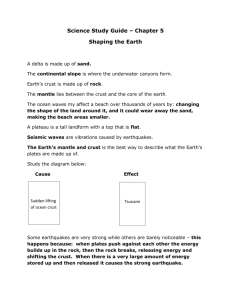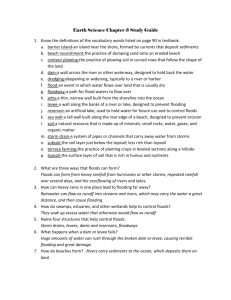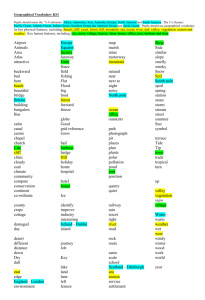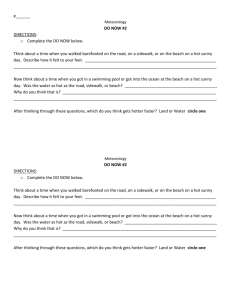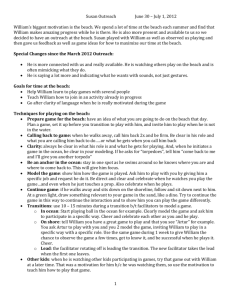Curriculum Directions Year 2-7 July
advertisement
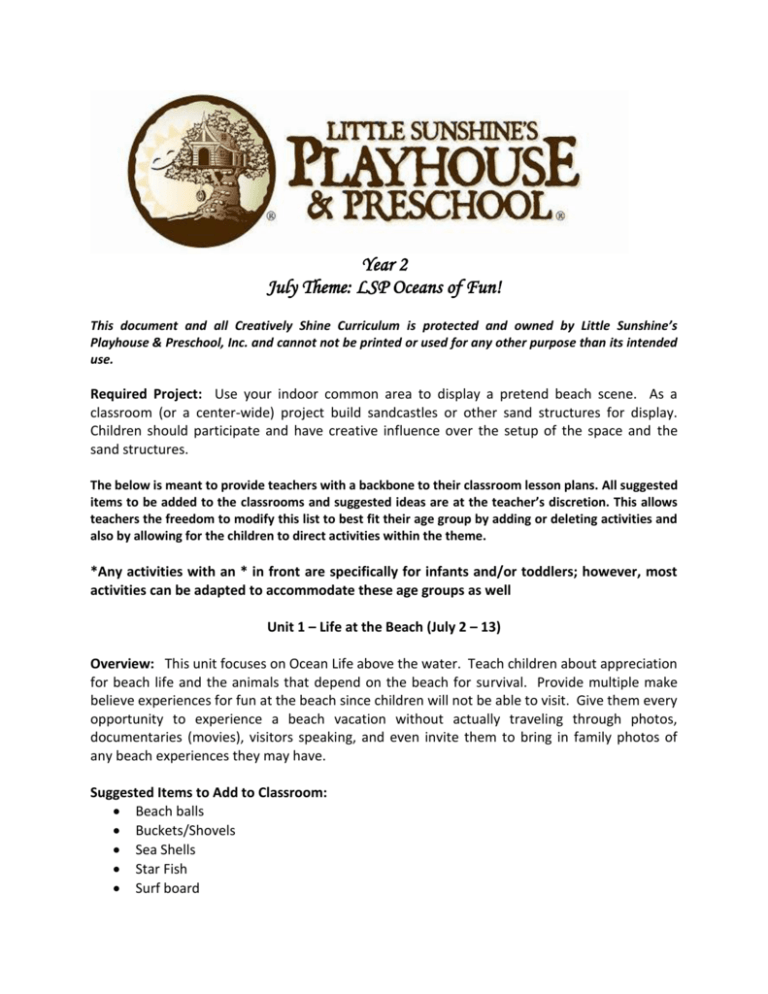
Year 2 July Theme: LSP Oceans of Fun! This document and all Creatively Shine Curriculum is protected and owned by Little Sunshine’s Playhouse & Preschool, Inc. and cannot not be printed or used for any other purpose than its intended use. Required Project: Use your indoor common area to display a pretend beach scene. As a classroom (or a center-wide) project build sandcastles or other sand structures for display. Children should participate and have creative influence over the setup of the space and the sand structures. The below is meant to provide teachers with a backbone to their classroom lesson plans. All suggested items to be added to the classrooms and suggested ideas are at the teacher’s discretion. This allows teachers the freedom to modify this list to best fit their age group by adding or deleting activities and also by allowing for the children to direct activities within the theme. *Any activities with an * in front are specifically for infants and/or toddlers; however, most activities can be adapted to accommodate these age groups as well Unit 1 – Life at the Beach (July 2 – 13) Overview: This unit focuses on Ocean Life above the water. Teach children about appreciation for beach life and the animals that depend on the beach for survival. Provide multiple make believe experiences for fun at the beach since children will not be able to visit. Give them every opportunity to experience a beach vacation without actually traveling through photos, documentaries (movies), visitors speaking, and even invite them to bring in family photos of any beach experiences they may have. Suggested Items to Add to Classroom: Beach balls Buckets/Shovels Sea Shells Star Fish Surf board Sand crabs Sand and toys to sculpt sand Hat/Visor Suggested Ideas for Focus on the Whole Child: Social/Emotional Make a picnic (during snack time) to eat at a pretend beach Have a life guard visit the school Compare and contrast different sand Color sand and layer into fun containers or jars Taste fresh water and salt water Listen to a sea shell at group time Dress up in grass skirts and hula dance Use macaroni shells to make a necklace for a family member Pretend to go deep sea fishing off the tree house on the playground Physical (fine/gross motor) Use water colors to paint a day at the beach, add on sand, shells, etc. Make surf boards and learn about the sport of surfing Make an octopus and count the legs Use clay to make a star fish then paint it Make a lei necklace Play pretend beach volleyball (team work focus) Play shark tag on the playground (cardio exercise) Turn your tree house (outside) into a sinking ship Have children do the crab walk race *Sea shell clear shaker bottle – allow the children to experiment with it by shaking and rolling it *Push around beach balls Cognitive Point a fan on a container of water and observe waves at high, medium, and low power. Discuss wind and Tsunami’s Weigh sea shells on a scale or balance. Then chart which one weights the most to least Discuss tide pools at group time Cut out pictures of beach items and make a beach scrapbook Make flashcards to identify animals at the beach and practice at group time Discuss weather at the beach Show photos comparing beaches around the world Have children pack a beach bag (teach about preparation) Communication/ Language Put sand in trays and practice writing in sand with fingers (ABC’s and 123’s) Play musical instruments to make music of the ocean Sing “Waves in the Ocean go Up and Down”- to the tune of “Wheels on the Bus” Talk about school of fish – count the fish Make beach costumes and play dress up- crab, sea gull, etc. Learn ocean words in sign and second language Workbook Curriculum Workbook curriculum should be carried out daily in each classroom with (children over the age of 12 months) for 10-20 minutes, depending on age. At this time we are not mandating what brand or type of workbook. Workbooks should teach general cognitive principals for the child’s age (colors, shapes, tracing, recognition, memorization, numbers, and alphabet). The activity should be in paper form and available for parents to review at least weekly. This addition to our curriculum is a supplement needed to meet the expectations of families and further prepare children for Kindergarten. Workbook curriculum is not considered a creative art experience; it is merely a supplement to encourage cognitive growth. Unit 2 – Under the Sea at LSP (July 16 – 27) Overview: This unit focuses under the sea. Create an educational rich environment promoting a passion for learning about the ocean and the creatures that inhabit the ocean. Children should leave this unit with foundational knowledge and a variety of fun experiences to share with their parents. Suggested Items to Add to Classroom: Life Jackets Goggles Wet Suit Flippers Snorkeling Equipment Suggested Ideas for Focus on the Whole Child: Social/Emotional Read the Little Mermaid (or watch the movie) then pretend to be a mermaid or merman Listen to cd’s with ocean sounds (whales or wave sounds) Discuss hurricanes and evacuation procedures Discuss animals that remain together as families in the ocean Discuss ocean pollution and things children can do to help the ocean Have a scuba diver visit the school and show equipment / photos Physical (fine and gross motor) Use puffy paint to create different fish Make a sea turtle Play sting ray tag Pretend to be a sea turtle and bury eggs Pretend to be fish swimming in the ocean in schools (group cooperation) Fill a container with shaving cream and ocean fish, search through the shaving cream to find and identify the fish Set up an ocean scavenger hunt on the playground Make a mermaid tail *Wet a sponge or wash cloth and allow the children to sqeeze all of the water back into a small tub or sensory table (keep a close eye on the children during this activity) Cognitive Identify oceans on a map or globe of the world Identify the Atlantic and Pacific Oceans Identify animals that live inside shells in the ocean Read “Rainbow Fish” and then make one using tissue paper Discuss fish and their teeth (show real photos) Discuss dangers in the ocean Identify using flashcards mammals vs. fish in the ocean Identify animals that can live in fresh and saltwater Show the lifecycle of a fish or shark *Place a thin layer of sand at the bottom of small tub or sensory table and add an inch of water for the children to explore (keep a close eye on the children during this activity) Communication/ Language Chart the length of ocean fish and/or whales Sing “Take Me Out to the Ocean”- make up the words Discuss (and display to the extent possible) how animals communicate (dolphins, etc) Teach children a hand gesture for a dolphin command- be a pretend trainer Display real under the sea photos and write a descriptive word or sentence with each photo promoting a literacy rich environment Learn under the sea words in sign and second language Workbook Curriculum Workbook curriculum should be carried out daily in each classroom with (children over the age of 12 months) for 10-20 minutes, depending on age. At this time we are not mandating what brand or type of workbook. Workbooks should teach general cognitive principals for the child’s age (colors, shapes, tracing, recognition, memorization, numbers, and alphabet). The activity should be in paper form and available for parents to review at least weekly. This addition to our curriculum is a supplement needed to meet the expectations of families and further prepare children for Kindergarten. Workbook curriculum is not considered a creative art experience; it is merely a supplement to encourage cognitive growth.
